Surf II: The End of the Trilogy
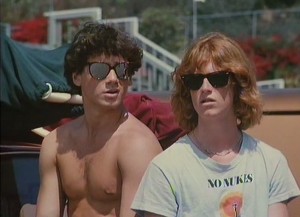 It may sound like a truly terrible idea, but I’ve based my entire life on lessons learned from the films of John Travolta. Watching Battlefield Earth, I gleaned that in order to control a planet of human beings; one must wear enormous platform shoes as well as repeatedly hit your head on low ceilings. This theme carried over from Phenomenon where we can surmise that massive head or brain trauma is likely to open you up to a new world of information and wisdom, creating, to quote another Travolta film, Pulp Fiction, a moment of clarity.
It may sound like a truly terrible idea, but I’ve based my entire life on lessons learned from the films of John Travolta. Watching Battlefield Earth, I gleaned that in order to control a planet of human beings; one must wear enormous platform shoes as well as repeatedly hit your head on low ceilings. This theme carried over from Phenomenon where we can surmise that massive head or brain trauma is likely to open you up to a new world of information and wisdom, creating, to quote another Travolta film, Pulp Fiction, a moment of clarity.
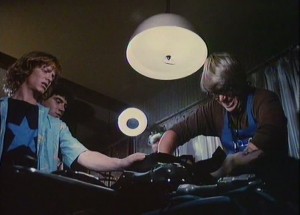 That’s why it makes perfect sense that Surf II: The End of the Trilogy writer/director Randall M. Badat was inspired to pen his only produced screenplay after suffering a surfing accident where a surfboard went through his cheek. Jettisoning his potentially promising screenwriting career writing studio family films, Badat poured all of his energy into his Surf parody opus, written over a long weekend under the influence of Novocaine and other heavy painkillers. He ignored his big time Hollywood agent’s advice, who told Badat that the screenplay for what would turn out to be Surf II was the worst thing he’d ever read. Finding some feeble financing, Badat shot the film quickly, intended as a parody of beach films, using the punk culture that irritated him on the beach as villains, and poking fun at the pervasive environmental recklessness that caused the beaches to be littered with toxic waste and other tasty unnatural treats.
That’s why it makes perfect sense that Surf II: The End of the Trilogy writer/director Randall M. Badat was inspired to pen his only produced screenplay after suffering a surfing accident where a surfboard went through his cheek. Jettisoning his potentially promising screenwriting career writing studio family films, Badat poured all of his energy into his Surf parody opus, written over a long weekend under the influence of Novocaine and other heavy painkillers. He ignored his big time Hollywood agent’s advice, who told Badat that the screenplay for what would turn out to be Surf II was the worst thing he’d ever read. Finding some feeble financing, Badat shot the film quickly, intended as a parody of beach films, using the punk culture that irritated him on the beach as villains, and poking fun at the pervasive environmental recklessness that caused the beaches to be littered with toxic waste and other tasty unnatural treats.
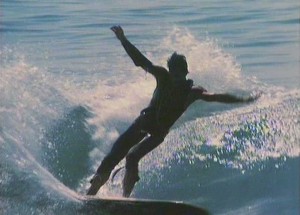 Whatever Badat was trying to do surely isn’t on screen. Surf II makes the surfers look like condescending elitists (the slobs are actually the snobs) who hate the public, opportunistic heels who will cheat on their loyal girlfriends whenever possible. On the other hand, the zombified punks, who have ingested toxic waste that originated from deliberately tainted cola, come off as goofy, but harmless dopes, who happen to be under the control of vengeful outcast Menlo Schwatzer (professional nerd Eddie Deezen) bent on taking his anger out on the local surfers. What may have been a parodic idea, that there are no consequences in beach movies, which accounts for the pure incoherence of the story points, undermines the threat of the punks.
Whatever Badat was trying to do surely isn’t on screen. Surf II makes the surfers look like condescending elitists (the slobs are actually the snobs) who hate the public, opportunistic heels who will cheat on their loyal girlfriends whenever possible. On the other hand, the zombified punks, who have ingested toxic waste that originated from deliberately tainted cola, come off as goofy, but harmless dopes, who happen to be under the control of vengeful outcast Menlo Schwatzer (professional nerd Eddie Deezen) bent on taking his anger out on the local surfers. What may have been a parodic idea, that there are no consequences in beach movies, which accounts for the pure incoherence of the story points, undermines the threat of the punks.
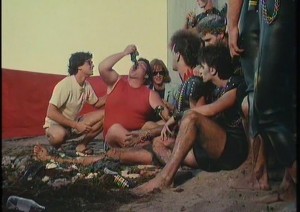 Badat walks the parody line all throughout Surf II, so when a gag doesn’t work, and that’s pretty often, there’s no way to tell if that was the point all along. Is the joke about “putting the fruit juices next to the gay magazines” supposed to poke fun at all the lazy teen exploitation movies made around the same time as Surf II (released in early 1984) who used homophobic insults as a go-to-punchline? Probably not, but it could easily be Badat’s way of making sure we know how intolerant and evil Menlo’s henchmen are. The fact that these henchmen are also the parents of the protagonist surfers, one of whom is played by Eric Stoltz (who gives a charmless performance, but at least avoids the easy temptation of imitating Fast Times’ Spiccoli), is almost accidental commentary. Even if Stoltz and his friends are at odds with their fathers, they still inherited corrupted genes.
Badat walks the parody line all throughout Surf II, so when a gag doesn’t work, and that’s pretty often, there’s no way to tell if that was the point all along. Is the joke about “putting the fruit juices next to the gay magazines” supposed to poke fun at all the lazy teen exploitation movies made around the same time as Surf II (released in early 1984) who used homophobic insults as a go-to-punchline? Probably not, but it could easily be Badat’s way of making sure we know how intolerant and evil Menlo’s henchmen are. The fact that these henchmen are also the parents of the protagonist surfers, one of whom is played by Eric Stoltz (who gives a charmless performance, but at least avoids the easy temptation of imitating Fast Times’ Spiccoli), is almost accidental commentary. Even if Stoltz and his friends are at odds with their fathers, they still inherited corrupted genes.
 Badat’s complete lack of control over Surf II is exactly what helps him during some of the more Airplane-based segments. Just when you think the movie is going to mire itself in dead spots, there’ll be a surprising sequence. These include a scene when Stoltz* and his science teacher dissect the insides of the zombie punks, and while all of the car parts that come out are silly but expected, the moment where the teacher finds an album near the intestines, and says “oh, that’s my Dick Dale* record” is pretty clever. Throwaway jokes catch you off guard, such as when bodies discovered in the ocean lead to a Jaws joke, but with a twist, “Could it be a great white!? No, it looks like a couple of professionals.”
Badat’s complete lack of control over Surf II is exactly what helps him during some of the more Airplane-based segments. Just when you think the movie is going to mire itself in dead spots, there’ll be a surprising sequence. These include a scene when Stoltz* and his science teacher dissect the insides of the zombie punks, and while all of the car parts that come out are silly but expected, the moment where the teacher finds an album near the intestines, and says “oh, that’s my Dick Dale* record” is pretty clever. Throwaway jokes catch you off guard, such as when bodies discovered in the ocean lead to a Jaws joke, but with a twist, “Could it be a great white!? No, it looks like a couple of professionals.”
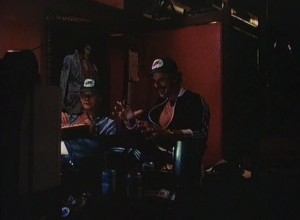 That particular joke is delivered by the adults in the film, who walk away with every scene. Surf II may be aimed at teenagers, but it falls into the same trap as similar movies like Spring Break, Joysticks, Hot Resort, and Hardbodies, where the teenagers rarely look to be under the age of 30, causing a major disconnect for the audience. Supporting players like Cleavon Little (as the high school principal, Daddy-O) and Lyle Waggoner (as local cop Chief Boyardie) navigate the treacherous waters with aplomb, wading past the absolutely non-sensical plot, where, for whatever reason, a surfing competition is some sort of school-moderated activity. That actors like Terry Kiser*** (Bernie from Weekend at Bernie’s) have trouble is not their fault, because they get unplayable scenes without any proper context (likely edited out), like the one where Kiser argues with Menlo’s henchmen about whether he can put his baked beans on the same picnic table as the one where they are selling their poisoned soda.
That particular joke is delivered by the adults in the film, who walk away with every scene. Surf II may be aimed at teenagers, but it falls into the same trap as similar movies like Spring Break, Joysticks, Hot Resort, and Hardbodies, where the teenagers rarely look to be under the age of 30, causing a major disconnect for the audience. Supporting players like Cleavon Little (as the high school principal, Daddy-O) and Lyle Waggoner (as local cop Chief Boyardie) navigate the treacherous waters with aplomb, wading past the absolutely non-sensical plot, where, for whatever reason, a surfing competition is some sort of school-moderated activity. That actors like Terry Kiser*** (Bernie from Weekend at Bernie’s) have trouble is not their fault, because they get unplayable scenes without any proper context (likely edited out), like the one where Kiser argues with Menlo’s henchmen about whether he can put his baked beans on the same picnic table as the one where they are selling their poisoned soda.
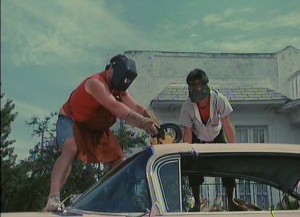 Still, Surf II is often saved whenever it cuts to Deezen and his rapid-fire utterances of Badat’s cobbled together dialogue. Deezen deserved far more screen time than Stoltz, who is only funny when he tries to fake surf in front of some shoddily composited blue screens. Even when Badat saddles Deezen with a half-cocked mocking of the conclusion of Sleepaway Camp, Deezen speeds through it like an amped up Bugs Bunny. Whatever Badat’s miniscule contributions to cinema (possibly inspiring both Back to the Beach and Surf Nazis Must Die!, making a beach movie that doubles as commentary about the social and cultural division), he should at least be credited with giving Deezen one of his few lead roles.
Still, Surf II is often saved whenever it cuts to Deezen and his rapid-fire utterances of Badat’s cobbled together dialogue. Deezen deserved far more screen time than Stoltz, who is only funny when he tries to fake surf in front of some shoddily composited blue screens. Even when Badat saddles Deezen with a half-cocked mocking of the conclusion of Sleepaway Camp, Deezen speeds through it like an amped up Bugs Bunny. Whatever Badat’s miniscule contributions to cinema (possibly inspiring both Back to the Beach and Surf Nazis Must Die!, making a beach movie that doubles as commentary about the social and cultural division), he should at least be credited with giving Deezen one of his few lead roles.
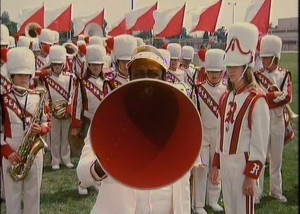 * Stoltz was known for using his spare time working on sets, doing whatever menial job was available. He was a gaffer on Say Anything, and considering the sloppiness of Surf II, we know he wasn’t moonlighting as the script supervisor.
* Stoltz was known for using his spare time working on sets, doing whatever menial job was available. He was a gaffer on Say Anything, and considering the sloppiness of Surf II, we know he wasn’t moonlighting as the script supervisor.
** Dick Dale wrote surf music, such as the very famous song used in the opening restaurant robbery scene in Pulp Fiction, which also co-starred Eric Stoltz.
*** Kiser’s movie wife in Surf II, played by former Johnny Carson bit player Carol Wayne, drowned the year after Surf II was released.



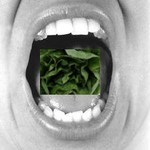
Anonymous says:
February 12th, 2017
10:28 pm
Greatest movie of all time
Emilian Moreno says:
November 15th, 2018
11:41 am
My father took me to see this movie when I was fourteen. I loved it. It’s too bad they won’t give it a BluRay or 4K release because this movie deserves it. It’s one of the best comedies of all time!
rad girl says:
March 26th, 2019
3:38 am
what a BLAST from the PAST!